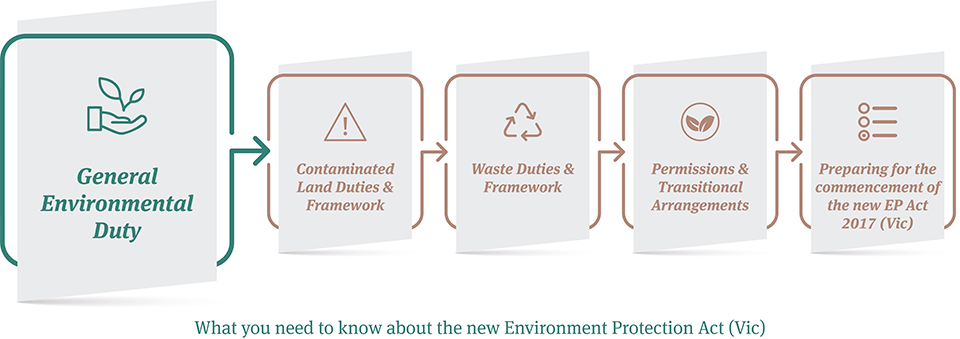
On 1 July 2021 the Environment Protection Act 2017 (Vic) incorporating amendments from the Environment Protection Amendment Act 2018 (Vic) (New Act) as well as the Environment Protection Regulations 2021 will come into force.
The new environment protection framework will shift the focus from punishing polluters who cause harm to human health or the environment to a focus on prevention of harm through a positive duty-based regime.
This regime will require companies to prevent and manage risks of harm to people and the environment from their activities and be able to establish their ongoing efforts in doing so.
What is the general environmental duty?
The introduction of the general environmental duty (GED) as a cornerstone enforceable duty applies where:
“a person engaging in an activity that may give rise to risks of harm to human health or the environment from pollution or waste must take reasonably practicable steps to minimise those risks”.
Activities that may attract the GED are likely to include:
- Those involving production of noise, odour, dust or stormwater run-off.
- Excavation of potentially contaminated soil.
- Chemical use and storage.
- Generating, storing, transporting or disposing of wastes.
The duty is broad in scope so will extend to other activities.
Who owes this duty?
Anyone conducting an activity that poses risks to human health and the environment which, in theory, could include all Victorian businesses and individuals.
An equivalent duty exists in other Australian jurisdictions. However, unlike in those jurisdictions the Victorian GED will be enforceable with criminal and/or civil penalties if it is breached. This means that businesses could face a fine of over $1.65 million for breaching the GED.
Company officers could be fined up to $660,000 as well as up to 5 years’ imprisonment where the breach is intentional or reckless and for corporations a reckless breach could result in a fine of up to $3.3 million.
Company officers will need to exercise due diligence and have a proactive approach to ensuring their organisation is complying with the GED and other duties imposed by the New Act.
What are reasonably practicable steps?
What is reasonable practicable to minimise risks will involve taking steps that are proportionate to the risk of harm including considering:
- The likelihood of those risks eventuating.
- The degree of harm that would result if those risks eventuated.
- The state of knowledge about the harm or risks of harm and any ways of eliminating or reducing those risks.
- The availability and suitability of ways to eliminate or reduce those risks.
- The cost of eliminating or reducing those risks.
What do you need to do to prepare before 1 July 2021?
Before the New Act commences, organisations can prepare for the New Act by:
- Familiarising themselves with EPA guidance – the EPA has commenced publishing guidance relevant to the GED including what is reasonably practicable and risk management, as well as industry-specific guidance for managing risks (e.g. for the construction and waste and recycling sectors) and will continue to publish further guidance, compliance codes and position statements. We recommend your organisation understands the EPA’s compliance expectations.
- Undertaking a self-assessment and implementing appropriate changes – businesses should conduct a thorough analysis of their current practices, systems and operations and:
- Identify all risks posed by their activities to human health and the environment.
- Where risks are identified, assess the severity of the risk and the likelihood of it occurring and its consequence.
- Identify ways to eliminate or reduce the risks so far as is reasonably practicable.
- Implement appropriate risk controls – businesses should place a high priority on ensuring their practices, systems (such as environmental management systems) and operations have suitable risk control measures in place to align with the new regulatory framework, including the GED.
- Ensure staff and contractors are given appropriate training, information and supervision to eliminate or manage any risks.
- Preparing a management and monitoring plan – Licence holders will be required to develop a Risk Management and Monitoring Plan (RMMP). Either prepare a plan yourself or engage an environmental consultant to assist. We suggest that businesses that may not need an EPA permission consider using the RMMP framework to undertake the self-assessment suggested above.
- Preparing documentation – all work done in terms of risk assessment, implementation and compliance should be well documented, so that it can be used to demonstrate compliance with the GED.
Do you have a question, need some advice or a training workshop? Contact a member of our team below.











